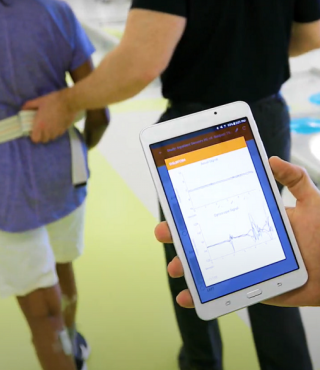Chronic TBI: (Whiteneck, Gerhart, et al, 2004; n = 73; mean age at injury: 16-30 years old= 44, 31-45 years old=19, 46-60 years old=10; gender=55, male; CHIEF long form was used in this study)
Discharge FIM Physical sub-scale = 83.5 (11.0), Cognitive Sub-scale = 27.9 (4.32) points)
|
CHIEF Total and sub-scale scores with other 1-year outcomes
|
|
|
|
|
|
|
|
1-year outcomes
|
Total CHIEF
|
Physical barriers
|
Attitudes and barriers
|
Services and assistance
|
Policies
|
Work / School
|
|
Life satisfaction (SWLS)
|
−0.39*
|
−0.40*
|
−0.30*
|
−0.23
|
−0.27*
|
−0.16
|
|
total CHART
|
−0.38*
|
−0.18
|
−0.33*
|
−0.29*
|
−0.20
|
−0.29
|
|
Cognitive independence
|
−0.26*
|
−0.10
|
−0.29*
|
−0.30*
|
−0.17
|
−0.12
|
|
Physical independence
|
−0.11
|
−0.04
|
−0.25*
|
−0.13
|
−0.07
|
--
|
|
Mobility
|
−0.33*
|
−0.33*
|
−0.28*
|
−0.28*
|
−0.28*
|
−0.18
|
|
Social integration
|
−0.16
|
−0.16
|
−0.26*
|
−0.13
|
−0.20
|
−0.16
|
|
Occupation/productive
|
−0.37*
|
−0.29*
|
−0.30*
|
−0.35*
|
−0.23*
|
−0.33*
|
|
Economic self-sufficiency
|
−0.16
|
−0.02
|
−0.18
|
−0.09
|
−0.12
|
−0.10
|
|
*p < .05 using the Spearman’s rho correlation.
|
|
|
|
|
|
|
|
r < = Poor
r .31 to .59 = Adequate
r > .6 = Excellent
|
|
|
|
|
|
|
|
SWLS = Satisfaction with Life Scale
CHART = Craig Handicap Assessment and Reporting Technique
|
|
|
|
|
|
|
Chronic TBI : (Whiteneck, Gerhart, et al, 2004; n=73; mean age at injury: 16-30 years old= 44, 31-45 years old=19, 46-60 years old=10; gender=55, male; CHIEF long form was used in this study)
|
Mean product scores for CHIEF and FIM
|
|
|
|
|
|
|
|
|
FIM Sub-scale
|
Total Score Strength
|
Total CHIEF
|
Physical Barriers
|
Attitudes and Support
|
Services and Assistance
|
Politics
|
Work / School
|
|
Physical independence items ≥ 6*
|
Adequate
|
0.44
|
0.51
|
0.40
|
0.43
|
0.44
|
0.26**
|
|
Physical independence items not ≥ 6
|
Excellent
|
0.76
|
0.93
|
0.72
|
0.69
|
0.82
|
0.55**
|
|
Cognitive independence items ≥ 6*
|
Poor
|
0.28**
|
0.41
|
0.23
|
0.31
|
0.27**
|
0.13
|
|
Cognitive independence items not ≥ 6
|
Excellent
|
0.69**
|
0.80
|
0.54
|
0.58
|
0.61**
|
0.37
|
|
**p < .05 Mann-Whitney Test for 2 groups; Kruskal-Wallis Test for more than 2 groups
|
|
|
|
|
|
|
|
|
*indicating independence without assistance from others
|
|
|
|
|
|
|
|
|
Pearson Correlations of CHIEF and other 1 year outcomes
|
|
|
|
|
|
|
|
1-year outcomes
|
Total CHIEF
|
Physical barriers
|
Attitudes and barriers
|
Services and assistance
|
Policies
|
Work-School
|
|
Life Satisfaction (SWLS total score)
|
-0.39†
|
-0.40†
|
-0.30†
|
-0.23
|
-0.27†
|
-0.16
|
|
Handicap/lack of social participation (total CHART)
|
-0.38†
|
-0.18
|
-0.33†
|
-0.29†
|
-0.20
|
-0.29
|
|
Cognitive Independence (CHART subscale)
|
-0.26†
|
-0.10
|
-0.29†
|
-0.30†
|
-0.17
|
-0.12
|
|
Physical Independence (CHART subscale)
|
-0.11
|
-0.04
|
-0.25†
|
-0.13
|
-0.07
|
‡
|
|
Mobility (CHART subscale)
|
-0.33†
|
-0.33†
|
-0.28†
|
-0.28†
|
-0.28†
|
-0.18
|
|
Social Integration (CHART subscale)
|
-0.16
|
-0.16
|
-0.26†
|
-0.13
|
-0.20
|
-0.16
|
|
Occupation/productive capacity (CHART subscale)
|
-0.37
|
-0.29†
|
-0.30†
|
-0.35†
|
-0.23†
|
-0.33†
|
|
Economic self-sufficiency (CHART subscale)
|
-0.16†
|
-0.02
|
-0.18
|
-0.09
|
-0.12
|
-0.10
|
†P < .05 using the Spearma n’s rho correlation; ‡‡Correlation not calculated


